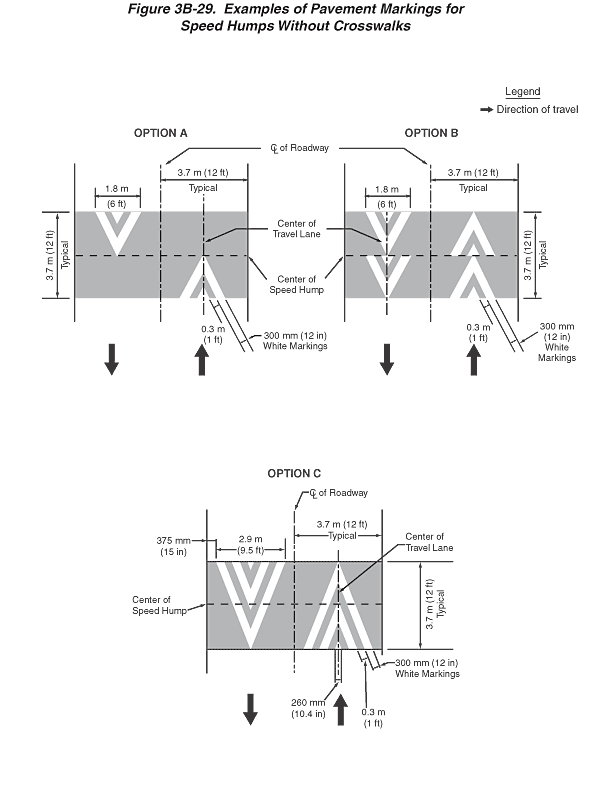|

Figure 3B-29. Examples of Pavement Markings for Speed Humps Without
Crosswalks
This figure illustrates three examples of pavement markings for
speed humps without crosswalks.
The markings are shown as white "v" shaped markings inside
a second "v" shape. Speed humps are shown with a dimension
(noted as "typical") of 3.7 m (12 ft) longitudinally across
both lanes of a two-lane two-way roadway. The travel lanes are each
shown as 3.7 m (12 ft) wide, and this width is denoted as "typical."
The "v" shaped markings are shown as centered in each
travel lane, with the point of each "v" pointing in the
direction of traffic flow in the lane. The lines making the "v"
are shown at a dimension of 300 mm (12 in) wide. The space between
the two sets of "v" markings is shown at a dimensioned
distance of 0.3 m (1 ft) wide. A legend shows a black arrow indicating
the direction of travel in the lanes.
The figure shows options A, B, and C:
- Option A shows a two-lane roadway segment with arrows indicating
one lane of travel in each direction. One speed hump marking is
shown on the pavement in each direction, with the base of the
"v" shown at the near edge of the speed hump and the
point of the "v" shown at the center of the speed hump.
The marking is shown as 1.8 m (6 ft) wide at the base of the "v."
- Option B shows a two-lane roadway segment with arrows indicating
one lane of travel in each direction. Two speed hump markings
are shown on the pavement in each direction, with the base of
the first "v" shown at the near edge of the speed hump
and the point of that first "v" shown at the center
of the speed hump. The base of another "v" is shown
beginning at the center of the speed hump with the point of that
second "v" ending at the far edge of the hump. The markings
are shown as 1.8 m (6 ft) wide at the base of the "v."
- Option C shows a two-lane roadway segment with arrows indicating
one lane of travel in each direction. A larger speed hump marking
is shown as 2.9 m (9.5 ft) wide at the base of the "v."
The marking is shown as a dimension of 375 mm (15 in) from each
edge of the travel lane. One speed hump marking is shown in each
direction, with the base of the "v" shown at the near
edge of the speed hump and the point of the space between the
inside and outside "v" lines shown at the center of
the speed hump and the point of the outside "v" shown
as ending at the far edge of the speed hump. The width of the
point of the innermost "v" line at the near edge of
the hump is shown as a dimension of 260 mm (10.4 in).
Back
to Chapter 3B
|

